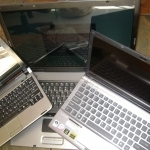
With sales approaching only 400,000 units in 2007, netbook sales exploded in 2008 reaching 11. 4 million units. Small, light, and super-portable are the catchwords describing a netbook. Definitions vary but the determining factors are price and size. Generally they have a screen size of 10″ or below, a reduced power/performance processor with 1.0 and 1.6 gig. the most popular of sizes. Price is dictating the use of limited amounts of memory but drive size has been creeping up.
The force behind this rapid raise in market share appears to be the world wide economic slump. What a netbook is and what it’s designed to do doesn’t seem to be clear to consumers. Changing features and trends are blurring the line between netbooks and notebooks even before the definition of netbook is established. Consumer confusion is increasing as this cannibalization of the slumping laptop market grows. But blurred vision or not, the netbook is the one product bolstering the PC makers who face a market saturated with laptops, reduced IT budgets, and consumers struggling to stay afloat.
Numbers and Facts
1. Eight of the Top 10 Mobile PCs on Amazon are netbooks.
2. Fourteen of of the Top 20 Mobile PCs on Amazon US are netbooks.
3. 48% of the Top 25 Laptops are netbooks (Price Grabber market report).
4. Linux once held the lion’s share (70%) of operating systems shipped on netbooks but returns and complaints of “too complicated” have dropped that figure to 30%. Linux is expected to continue slipping to a 10% share by the end of 2009.
5. One half of Europe’s netbook sales come from wireless carriers that offer the hardware as an incentive to capture wireless data users.
It’s theorized that once the global recession is behind us, the return to increased performance will again drive popularity of portables. Originally viewed as a second or third addition to ones computing arsenal, today netbooks are viewed by some as an alternative to more expensive appliances.
Is it? Can I really spend an average of $300.00 and replace my two-year-old, $899.00 laptop. On the surface it looks like it might be possible. My old laptop has a 1.6 gig Intel Core Duo processor, 2 GB of ram, a 32 GB SSD drive and a 17 inch screen. How bad could a netbook be? Take a look!
OVERDRIVE SCORES
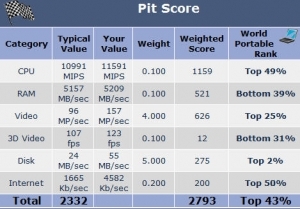
Gateway 17″Portable
- CPU Intel T2060 1.6 Dual Core
- Memory 2GB
- Drive 32Gb SSD
- Optical Drive DVD/CD
- Retail $899.99
- WT. 7.3 LBS.
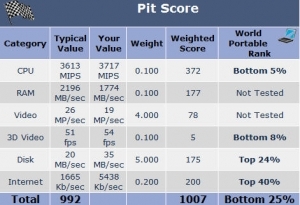
Dell Inspiron Mini 10″
- CPU Intel Z520 Atom 1.3
- Memory 1GB
- Drive 120 GB 5400 RPM
- No Optical Drive
- Retail $399.99
- WT. 2.86 LBS
Yikes, that’s not good! Looks like more than just the normal 200mhz difference in processor speed and available memory. Ohhh that’s right, this is only a single core processor. It’s been a while now since I’ve used a single core processor. What a difference. Now that I’m checking I see a big difference in processor cache also. In fact the memory and video tests didn’t even complete. Let’s bump it up a notch on the netbook side of things and move to the slightly larger 1.6 GHz processor. I would go larger if I could. I hear that there is a 1.8 available now but I can’t find one locally.
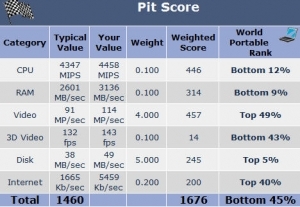
Acer Aspire One 8.9″”
- CPU Intel Atom N270 1.6 GHz
- Memory 1GB
- HDD 120 GB/7200rpm
- No Optical drive
- Retail New $299.99
- WT. 2.19 LBS
It’s easy to see that even though the two processors have the same clock speed they’re just not in the same game. The performance is not comparable and this is against a laptop that is two years old. This shouldn’t really be surprising. It’s not as if Intel designed these processors to compete with today’s latest and greatest. When processing power is what you need, you can’t expect to get it from a netbook. Yes, I know there are slightly faster netbooks but there are also slower netbooks. So long story short it’s easy to see that if you’re hoping to buy one of these inexpensive units as a laptop replacement you’ll be taking a huge performance hit. If tight purse strings is driving force behind the rise of the netbook then it won’t take it long to fall when things improve.
To tell the truth before I tested any of the netbooks I expected them to perform and score much better than they did. I had planned on buying one of the more expensive models available. Like the Dell I tested, some come with a 10″ screen and look more like a laptop replacement, but after seeing the initial tests with the Dell and the Acer One, I had seen enough.
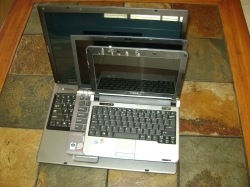
What I’m not mentioning is my frustrating reintroduction to bloatware and craplets. We’ve been reporting on it here for over 3 years. Bloatware was disappearing for a while after an avalanche of complaints and articles detailing the alarming amount of time necessary to clean what were supposed to be brand new computers. We even covered the improvement in “first boot” boot times and how that was achieved without manufacturers really reducing the junk. Unfortunately they can’t resist the opportunity to again ram this garbage down our throats and take advantage of the current, but in my opinion, short lived popularity of netbooks.
Good alternative for kids? Yes. Fun to play with? Maybe. Long-lived and much-loved portable like laptops? Not hardly. Even now I’m seeing a reduction in the number of choices available compared to what I saw 3 months ago. When I take a look at what’s available in a legitimate notebook with a real keyboard and a screen large enough to display a full web page, I know it’s just a matter of time before netbooks go the way of the 8 track.
Remember that blurring line I mentioned in the beginning? Well the blurring isn’t just about changes in netbooks, or changes in the buyers perception. The blurring is also taking place in the weight to performance factor in standard notebooks.
Take a look at the performance packed into this 12″ 3.3 LB notebook
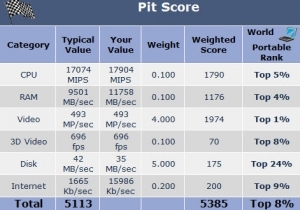
Sony Vaio VGN-Z520N
- CPU 2.2GHz DualCore
- Memory 3GB
- Nvidia Graphics
- HDD 120 GB
- Retail $1399.99
- WT. 3.3 LBS.
Talk about a lot of power in a small form factor. Not only that, but the screen size is still large enough to see without scrolling everything left and right, up and down. The keyboard is close enough to standard size that you can actually type in a normal fashion. This is the way I see things heading. Lightweight, plenty of power, and usability. This actually offers better performance than a lot of desktops I see. So does size matter? You bet it does, but it’s the size of your pocket and your hardware.




